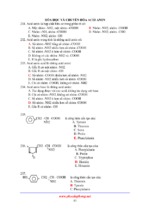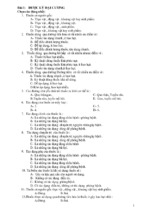Mô tả:
Complete Transposition of the
Great Arteries - Follow up
Le Kim Tuyen, MD
Transposition of the Great Arteries Repaired by
the Mustard or Senning Procedures
• 15%, will develop overt heart failure in late
follow-up
• More than mild systemic tricuspid
regurgitation may be present in 10–40%
• Atrial flutter occurs in 20% of patients by
age 20, and evidence of sinus node
dysfunction is seen in about 50% in the
adult age group
Transposition of the Great Arteries Repaired by
the Mustard or Senning Procedures (cont.)
• Shortened life expectancy takes the form of 70–
80% survival at 20- to 30-year follow-up.
• Regular echocardiography in skilled hands can
qualitatively assess systemic right ventricular
function, the degree of systemic tricuspid
regurgitation, the presence or absence of
subpulmonary left ventricular outflow tract
obstruction, as well as baffle leaks or
obstruction.
Transposition of the Great Arteries Repaired by
the Mustard or Senning Procedures (cont.)
• because echocardiography may not accurately
assess right ventricular systolic function or
acoustic access may be limited, periodic MRI
examinations may be of great value.
• If the patient has a pacemaker or other
contraindication to MRI, computerized
tomographic angiography may also be very
helpful in assessing the systemic right ventricle.
Transposition of the Great Arteries Repaired by
the Mustard or Senning Procedures (cont.)
Transposition of the Great Arteries Repaired by
the Mustard or Senning Procedures (cont.)
Transposition of the Great Arteries Repaired
by Arterial Switch
• The anatomic pulmonary valve must serve in the
systemic circulation lifelong, and there are
accumulating data on progressive neoaortic
valve dysfunction and root dilation during the
second and third decades of follow-up.
• Following the Lecompte maneuver both
pulmonary arteries are anterior to the ascending
aorta; posterior tension can cause further
distortion of the neoaortic root and/or cause
supravalvar pulmonary stenosis.
Transposition of the Great Arteries Repaired
by Arterial Switch (cont.)
11.7.1. Problems and Pitfalls
The following are potential problems and pitfalls
related to adults with d-TGA:
● Antiarrhythmic therapy, which might aggravate
sinus node dysfunction in patients after atrial
baffle operation, must be used cautiously.
● A detailed assessment of the atrial baffle for leak
and obstruction must be undertaken before
endocardial pacemaker implantation.
● There is potential for endocardial pacing leads to
exacerbate obstruction in the atrial baffle.
● The absence of typical symptoms of coronary
ischemia does not preclude the presence of
important ostial coronary artery disease in
patients with prior ASO.
11.8.1. Medical Therapy
The role of medical treatment (eg, ACE inhibitors
and beta blockers) to prevent or treat ventricular
dysfunction has only been studied in small
numbers, and its benefit is controversial
The role of ACE inhibitors and beta blockers
remains uncertain, and beta blockers may
precipitate complete AV block in patients with
preexisting sinus node dysfunction. Therapy for
heart failure now incorporates medications
directed at the renin-angiotensin-aldosterone
system.
11.8.2. Recommendations for Interventional
Catheterization for Adults With DextroTransposition of the Great Arteries
CLASS IIa
1. Interventional catheterization of the adult with d-TGA can
be performed in centers with expertise in the
catheterization and management of ACHD patients.
(Level of Evidence: C)
2. For adults with d-TGA after atrial baffle procedure
(Mustard or Senning), interventional catheterization can
be beneficial to assist in the following:
a. Occlusion of baffle leak. (Level of Evidence: B)
b. Dilation or stenting of superior vena cava or inferior vena
cava
pathway obstruction. (Level of Evidence: B)
c. Dilation or stenting of pulmonary venous pathway
obstruction.(Level of Evidence: B)
11.8.2. Recommendations for Interventional
Catheterization for Adults With DextroTransposition of the Great Arteries (cont.)
3. For adults with d-TGA after ASO, interventional
catheterization can be beneficial to assist in dilation or
stenting of supravalvular and branch pulmonary artery
stenosis. (Level of Evidence: B)
4. For adults with d-TGA, VSD, and PS, after Rastelli-type
repair, interventional catheterization can be beneficial to
assist in the following:
a. Dilation with or without stent implantation of conduit
obstruction (RV pressure greater than 50% of systemic
levels, or peak-to-peak gradient greater than 30 mm Hg;
these indications may be lessened in the setting of RV
dysfunction). (Level of Evidence: C)
b. Device closure of residual VSD. (Level of Evidence: C)
11.8.3. Recommendations for Surgical Interventions
11.8.3. Recommendations for Surgical Interventions
11.8.3. Recommendations for Surgical Interventions
11.8.3. Recommendations for Surgical Interventions
- Xem thêm -




















